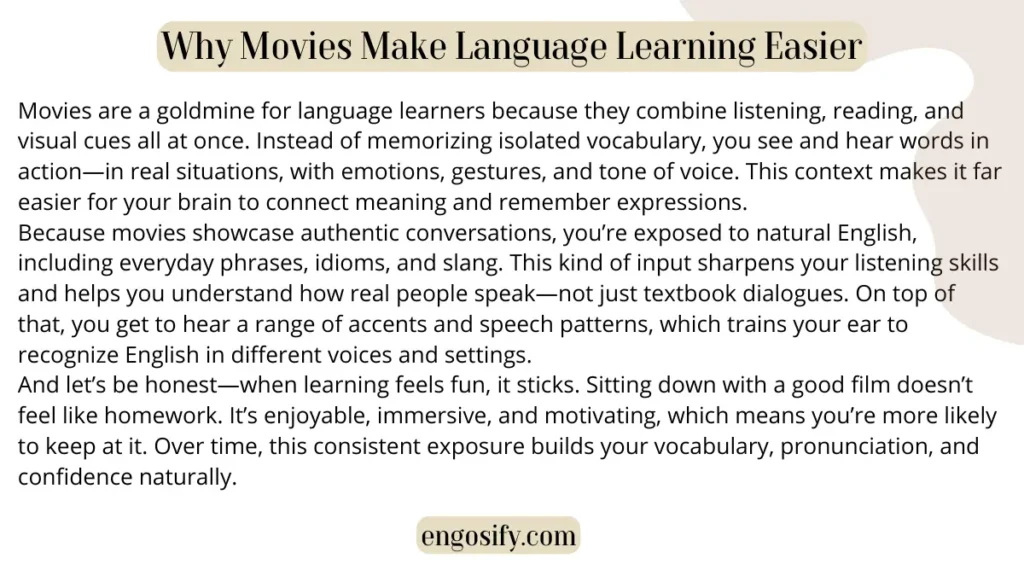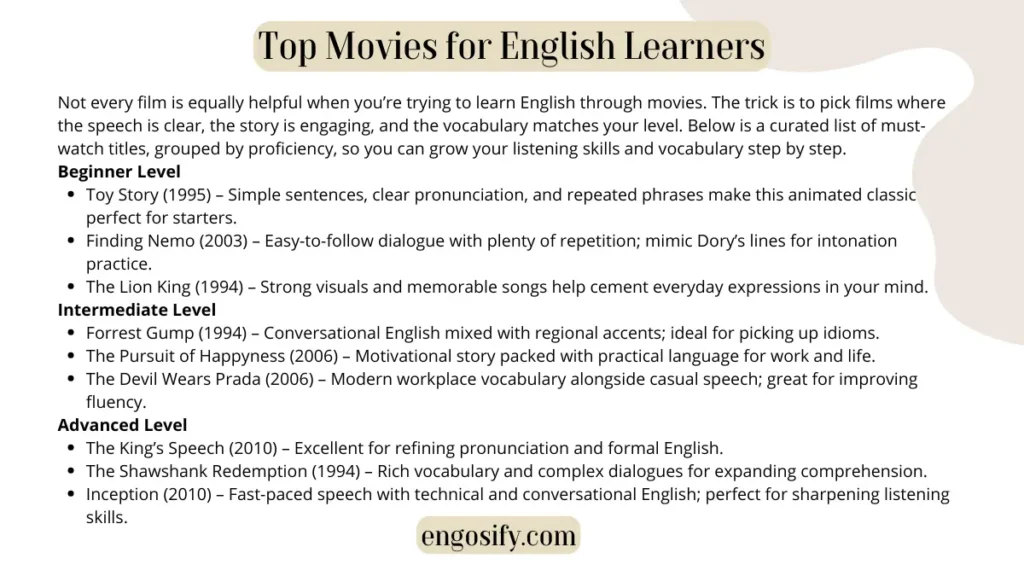Learning English doesn’t have to be boring or limited to dusty textbooks. In fact, one of the most fun, engaging, and effective ways to improve your English is by diving into movies. Watching films isn’t just entertainment—it’s a golden opportunity to pick up natural expressions, everyday vocabulary, and even cultural nuances that you won’t find in a grammar book. Whether you’re a beginner trying to get the hang of basic phrases or an advanced learner aiming to master pronunciation and idioms, movies can be your secret weapon. From animated classics to powerful dramas, there’s a perfect film for every stage of your English journey. And guess what? You can start learning today, right from the comfort of your home!
Movies give you real-life context, showing how people actually speak, react, and interact. Plus, seeing emotions, gestures, and situations alongside words makes understanding and remembering vocabulary and phrases so much easier. It’s like having a mini language lesson wrapped inside a story that keeps you hooked. In this article, we’ll guide you through everything you need to know—from picking the right movies, learning actively while watching, and discovering a curated list of films that will skyrocket your listening skills, pronunciation, and cultural awareness. So grab some popcorn (or not!), get comfy, and let’s dive into the ultimate guide to learning English through movies.
Why Learning English Through Movies is Effective
Why Movies Make Language Learning Easier
Watching movies is not just a fun pastime—it’s a powerful tool for language learning. Unlike traditional methods, movies immerse you in real conversations, tones, and accents. When you see the context of a word or phrase, your brain connects meaning faster and more naturally. Think about it: you’re not just memorizing vocabulary; you’re seeing it in action, which is exactly what you need to speak confidently in real-life situations.
Moreover, movies expose you to different accents and speech patterns, making your listening skills sharper. For instance, listening to dialogue in a drama may help you catch subtle emotional tones, while a comedy can teach you informal expressions and everyday slang. This variety builds a more well-rounded understanding of English, which textbooks alone often fail to deliver.
How Movies Improve Vocabulary and Pronunciation
One of the hidden perks of learning with movies is vocabulary acquisition. Every film introduces words naturally, often repeated throughout the story, which helps cement them in your memory. Pause, rewind, or repeat—you’re in control. Plus, by mimicking actors’ pronunciation, rhythm, and intonation, you can polish your own speech. This technique is particularly effective when combined with subtitles in English, which reinforces spelling and helps you notice word stress and sentence patterns.
You can even take it a step further by keeping a small notebook to jot down new words, idioms, or phrases, and later practicing them in sentences. Over time, your pronunciation, listening comprehension, and overall fluency improve significantly. If you’re looking for guidance on this method, check out FluentU’s approach to language learning through movies—they have some excellent tips for using films as a learning tool.
Cultural Understanding Through Films
Lastly, movies aren’t just about language—they’re windows into culture. By watching films from English-speaking countries, you’ll pick up on customs, humor, and social etiquette that shape the language itself. This cultural context makes learning not only more interesting but also practical because you begin to understand when and how certain expressions are used naturally.

Choosing the Right Movies to Learn English
Language Clarity and Pronunciation
Not all movies are created equal when it comes to learning English. Some films feature fast, mumbled speech or heavy slang that can leave even advanced learners scratching their heads. That’s why clarity of speech is crucial. Look for movies where actors speak clearly and naturally, using standard or neutral accents. This makes it easier to follow conversations, imitate pronunciation, and pick up new vocabulary. Animated films, family dramas, and educational films often excel in this area because the dialogue is carefully articulated for general audiences.
By focusing on movies with clear pronunciation, you can train your ear to different sounds, intonations, and speech patterns, which is especially helpful for improving both listening skills and spoken English. For practical advice on selecting films, you can explore Oxford Language Club’s top recommended movies for English learners, which lists beginner-friendly and intermediate options.
Genre Considerations
The type of movie you choose matters just as much as the language itself. Different genres offer unique benefits for language learning:
- Animated Films: Perfect for beginners. Dialogue is clear, vocabulary is simple, and plots are engaging.
- Comedies: Great for learning informal phrases, idioms, and everyday expressions.
- Dramas: Offer complex sentence structures, advanced vocabulary, and emotional nuance.
- Educational or Family Films: These often use straightforward dialogue and provide cultural insights that are easy to understand.
Mixing genres also keeps learning fun. One day, you might watch a lighthearted animated movie, and the next, a drama that challenges your comprehension skills. The variety ensures exposure to different accents, vocabulary, and cultural references, which accelerates your language acquisition.
Availability of Subtitles
Subtitles are your best friend when learning English through movies, but how you use them makes a huge difference. Beginners might start with subtitles in their native language to understand the story, but the ultimate goal is to switch to English subtitles. This approach reinforces word recognition, sentence structure, and spelling while you’re actively listening.
Advanced learners can even challenge themselves by turning subtitles off entirely to improve listening comprehension. Experiment with different methods to find what works best for you. Remember, the combination of visual cues, subtitles, and repetition is a powerful way to internalize vocabulary and phrases.
By carefully selecting movies with clear language, appropriate genres, and subtitle options, you set yourself up for a more productive and enjoyable learning experience. Making these choices thoughtfully is the first step toward mastering English while enjoying your favorite films.
Top Movies for English Learners
Watching the right movies can skyrocket your English skills, but choosing wisely is key. Here’s a curated list of films organized by proficiency level, complete with tips on how to learn from each.
Beginner Level
- Toy Story (1995)
Why it’s great: Simple dialogue, clear pronunciation, and universal themes make this animated classic perfect for beginners.
Learning tip: Focus on repeating short sentences and familiar expressions. Subtitles in English help connect words to pronunciation. - Finding Nemo (2003)
Why it’s great: Easy-to-follow plot with clear speech and plenty of repetition.
Learning tip: Pause and mimic the dialogue of characters like Marlin and Dory to improve your pronunciation and intonation. - The Lion King (1994)
Why it’s great: Strong storytelling and emotional context make vocabulary easier to remember.
Learning tip: Use scenes with songs and dialogues to pick up everyday expressions and cultural references.
Intermediate Level
- Forrest Gump (1994)
Why it’s great: Conversational English with some regional accents.
Learning tip: Note idiomatic expressions and repeat them in your own sentences. The storytelling style helps connect phrases to context. - The Pursuit of Happyness (2006)
Why it’s great: Motivational story with practical English for work, life, and personal interactions.
Learning tip: Watch emotionally charged scenes to better understand tone, emotion, and speech patterns. - The Devil Wears Prada (2006)
Why it’s great: Modern, professional vocabulary mixed with everyday phrases.
Learning tip: Focus on dialogue that uses business and casual English; practice repeating these lines aloud.
Advanced Level
- The King’s Speech (2010)
Why it’s great: Excellent for pronunciation practice and formal English.
Learning tip: Pay attention to articulation, rhythm, and emphasis; mimic King George’s speech to refine fluency. - The Shawshank Redemption (1994)
Why it’s great: Rich vocabulary and complex dialogues make this film ideal for advanced learners.
Learning tip: Take notes of new words and expressions, then try using them in your own sentences. - Inception (2010)
Why it’s great: Fast-paced dialogues with technical and conversational English.
Learning tip: Pause during complex scenes to understand context; this sharpens comprehension and critical listening skills.
By choosing films according to your level and actively engaging with the dialogue, you turn passive watching into a powerful language-learning session. Remember, it’s not about watching quickly—it’s about learning deeply, repeating phrases, and connecting words to context.
For additional tips on using movies to improve your English listening and comprehension, check out IMDb’s curated list of films for English learners. It’s a fantastic resource for discovering more options beyond this list.

Effective Strategies for Learning English with Movies
Watching movies is fun, but to really boost your English, you need to watch smart. Passive viewing only scratches the surface; active engagement transforms entertainment into a language-learning powerhouse.
Active Watching Techniques
First off, don’t just sit back and watch. Pause, rewind, and repeat lines aloud. This technique—sometimes called “shadowing”—helps your pronunciation, intonation, and fluency simultaneously. Keep a small notebook handy and jot down new words, idioms, or phrases. Later, try using them in sentences or short stories.
Additionally, mimic the way actors speak. Notice their pauses, stress on certain words, and the rhythm of conversation. Animated movies and comedies are perfect for this because the dialogue is clear and often exaggerated, making it easier to copy. Over time, your listening skills improve as your brain becomes trained to catch nuances in natural speech.
Utilizing Subtitles Effectively
Subtitles can be a game-changer if used correctly. Here’s a smart approach:
- Start with native-language subtitles for context if the plot is complex.
- Switch to English subtitles as soon as you feel comfortable. This reinforces vocabulary, spelling, and sentence structure.
- Challenge yourself by watching without subtitles once you’re confident. This pushes your comprehension and trains your ear for real-world English.
Remember, subtitles are not a crutch—they’re a bridge. They help your brain connect spoken English with written words, enhancing retention and understanding.
Engaging in Post-Movie Activities
After the credits roll, don’t just move on. Engage with the film to cement your learning:
- Discuss the movie in English with friends or online communities. Explain the plot, your favorite scene, or a character’s personality.
- Write a review or summary. This strengthens your writing skills and reinforces vocabulary.
- Role-play dialogues. Pick a favorite scene and act it out. This is not only fun but also perfect for practicing natural conversation flow and pronunciation.
These activities ensure that the language you hear doesn’t just vanish—it becomes part of your active English repertoire.
By combining active watching, smart subtitle use, and post-movie exercises, you turn every film into an immersive lesson. This strategy doesn’t just improve vocabulary and listening comprehension; it also builds confidence in speaking naturally in English.
FAQs
What Are the Best Movies for Beginners Learning English?
For beginners, the focus should be on clear pronunciation, simple dialogue, and engaging stories. Animated films like Toy Story, Finding Nemo, and The Lion King are ideal. They use everyday vocabulary and repeat phrases often, making it easier to memorize words and expressions. Watching these movies with English subtitles helps connect spoken words to written form, accelerating learning.
How Can I Improve My English Pronunciation Using Movies?
Pronunciation improves when you actively imitate actors. Pause and repeat lines, paying attention to intonation, stress, and rhythm. Shadowing, where you mimic speech as closely as possible, is especially effective. For structured guidance, you can explore FluentU’s approach to learning English with movies—they provide practical tips on repeating lines and practicing accents naturally.
Is It Necessary to Use Subtitles When Watching Movies for Language Learning?
Subtitles aren’t strictly necessary, but they’re extremely helpful, especially for beginners and intermediate learners. Start with native-language subtitles for context, then transition to English subtitles. Eventually, try watching without subtitles to challenge your listening comprehension. This gradual process enhances both vocabulary recognition and auditory skills.
Can Watching Movies Alone Improve My English Skills?
Absolutely! Watching movies alone can enhance listening, vocabulary, pronunciation, and even cultural understanding. However, the key is to watch actively. Take notes, repeat lines, and engage in post-movie exercises like summarizing or role-playing scenes. Combining movie-watching with other activities, such as speaking practice or writing exercises, maximizes results.
How Often Should I Watch Movies for English Learning?
Consistency beats quantity. Even 20–30 minutes of focused, active watching daily can improve fluency and comprehension over time. Rotate genres and difficulty levels to keep your learning experience diverse, stimulating, and enjoyable.
Conclusion
Watching movies isn’t just a way to pass the time—it’s a dynamic, enjoyable, and highly effective way to learn English. From improving your listening skills and pronunciation to expanding your vocabulary and gaining cultural insight, films provide a learning experience that textbooks simply can’t match.
By choosing movies wisely, using subtitles strategically, and engaging in active post-movie exercises, you transform entertainment into a powerful language-learning tool. Remember, the key is consistency and active participation—repeating phrases, shadowing dialogues, and reflecting on new expressions.
So, grab a film that matches your level, immerse yourself in the story, and let every scene, every line, and every word guide you toward fluent English. Whether it’s a heartwarming animated classic or a thought-provoking drama, every movie is a step closer to mastering the language in a fun and memorable way.
Learning English through movies is more than just practice—it’s an adventure. So turn on the lights, hit play, and let the journey begin!

